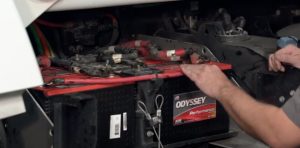Choosing the Right Battery to Fit the Diversified Assets of Your Fleet
 By Vicki Hall, Director, Transportation Technical Solutions at EnerSys, ODYSSEY Battery at EnerSys
By Vicki Hall, Director, Transportation Technical Solutions at EnerSys, ODYSSEY Battery at EnerSys
Maintaining a fleet of vehicles involves many challenges, and managing expenses is one of the toughest. There is no doubt that the best way to control expenses and keep vehicles on the road is to stick to a Preventive Maintenance (PM) schedule.
However, vehicle maintenance is one of the largest outgoing expenses, and strict adherence to budgets is mandatory; extending asset lifespan—essential. Most purchasing decisions are influenced, including the parts and supplies required for routine maintenance. Vehicle batteries fall squarely into this category.
While it may be tempting to search for a universal solution whenever possible and buy in bulk to receive a discount, the result may actually be counterproductive. Fleets are typically composed of a variety of vehicle types with different roles and demands. One size clearly doesn’t fit all—especially when it comes to vehicle batteries.
A better approach is to select a battery that provides the greatest cost efficiency and performs best for the type of vehicle and the demands placed upon it.
Battery Rating
Batteries are available in various Reserve Capacity (RC) and Cold Cranking Amps (CCA). An in-depth review of your fleet’s electrical requirements can help determine the most appropriate RC and CCA for your application and is worth the effort in the long term.
Choose Battery Type
There are three types of lead acid batteries used in fleet vehicle applications today: flooded electrolyte, Absorbed Glass Mat (AGM) and Thin Plate Pure Lead (TPPL) AGM batteries.
Several factors can help determine which type of battery may be best suited for a fleet vehicle:
- Typical number of vehicle starts, daily
- Vehicle workload (liftgates/reefers, etc.)
- Auxiliary loads (sleeper cabs)
- Battery location
- Ambient battery temperature
- Vehicle route application (intracity or interstate)
While the initial cost of AGM batteries is higher than flooded batteries, the return on investment is high as AGM batteries can meet the demands of vehicles, while providing significant advantages for fleets:
- Higher starting power—even at low temperatures and states of charge—compared to flooded batteries
- Better cycling, longer life, higher reliability
- Greater resistance to shock and vibration
- Completely sealed case
- Reduced maintenance—no need to add water
- Not considered hazardous freight
Among AGM batteries, Thin Plate Pure Lead (TPPL) batteries like ODYSSEY® batteries offer improved cost efficiency, providing long service life, reliable operation with great power delivery and dual-purpose operating support. These batteries have deep cycle capability and are suited for multiple discharges.
Given the challenges fleets are facing, moving to TPPL AGM batteries in their vehicles, where applicable, makes fiscal sense:
- Longer battery life results in a net cost savings.
- Higher reliability means TPPL AGM batteries help reduce unexpected costs
associated with no-starts. (Field no-starts are one of the most common and most expensive preventable expenditures. Preventing one field failure easily pays for a better battery.) - Essentially maintenance free, TPPL batteries with tin-plated brass terminals require no terminal maintenance. There is never a need to check level or add water.
- Removing routine battery maintenance tasks from the PM rotation schedule can help the service team better manage garage workload.
There isn’t a magic battery out there that reduces costs by fitting into every kind of vehicle in a fleet. However, there are better criteria by which to make your selection. You can’t go wrong when you make your decision based on vehicle requirements and choose the battery type that will yield the best returns for your fleet in performance, productivity and cost effectiveness.
Always be sure to follow the manufacturer’s guidelines for battery care and handling, and direct any questions to your local battery professional.
Learn more about how ODYSSEY® batteries deliver greater reliability and value: Technicians may refer to the ODYSSEY® Battery Technical Manual as a good source of information about how ODYSSEY® batteries work. A copy may be downloaded here.

